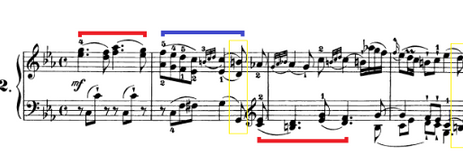Haydn Sonatas, Uncategorized
Haydn Sonata N° 33 in C Minor Hob.XVI.20
Haydn Sonata N° 33 in C Minor Hob.XVI.20
This Sonata is not just another of Haydn’s Sonata. It is the only one the composer ever had written in the minor mode.
The character and many resources related to the architecture show an evident influence in the earlier Beethoven’s work. Even though it is well known the fact of him spending some time under Haydn’s tuition, and many connections can be found between their music, we can appreciate in this piece more than any other a trailblazer showing the way for generations to come.
The three movements are in Sonata Form. Something very unusual, being the Romanze form the most used for slow movements, and the Rondo form the most preferred for the third ones. Almost twenty years later, Mozart will challenge this idea in reverse engineering and write his famous Sonata K331 in A major involving no movement out of the three in sonata form.
https://www.youtube.com/watch?v=V-2mMWqIAbA
FIRST MOVEMENT
The general architecture uses traditional Sonata form. As in many other Haydn sonatas, one of the main music-generators is the thirds, after that also sixths. The first subject has a gloomy melody that forces the harmony to resolve in the fifth degree, as an interrupted cadence, twice in the first four bars, presenting a Period according to Schoenberg’s terminology.
In the next image of the first four bars, we can appreciate:
– Red: Thirds, first used as the main theme and on the bar 3, as a mirrored accompaniment
– Blue: Sixths, nothing but thirds inverted, receiving the passing of the torch
– Yellow: Imperfect cadences. Little step back to resolve and then move on. It is a condensed piece to feature in just four bars:

The melody is stated again following the period structure, this time one octave lower and softly, dark and deep. This time the direction chosen to continue the action is climbing until an exciting peak. On bar 10, the bridge starts with fanfare power chords, inviting the guests to a fancy dance.
As always in Haydn’s music, whenever he presents an attractive idea, he repeats it twice, and this is no exception. The second time he emphasizes with some sudden dynamic changes, something primarily developed by Beethoven as well.
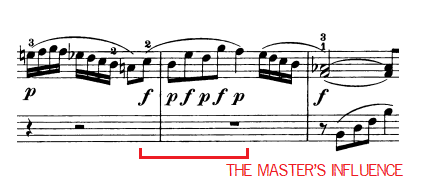
This Sonata is one of Haydn’s best Transitions; there is a dense motivic activity; A constant dialogue in between the right and the left hand is crowned with rich melodic expression; and after a section with shorter subdivision sextuplet semiquavers goes to an adagio.
All may happen easily in a Brahms Sonata, but in a Haydn’s work is something unusual to find. Before starting into the secondary theme, the composer asks us to play a dominant chord deployed note by note. In the graphic below the unusual Transition:
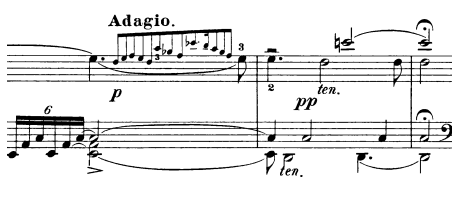
The secondary theme starts playfully in E flat Major with descendent short values. However, then the tension begins to rise and the right-hand climbs steeply, establishing the sextuplet semiquaver as a new rhythmic measure to add-up a background with refreshing countermelodies.

On the graph we can see how the right hand is singing with the subdivision in six, climbing with the first note of the pattern each time, until reaching a delicate leading note (high A-flat) and then how the left-hand keeps on with the same rhythm now as an accompaniment. The polyrhythm of four versus three, among the soft mood and crisp articulation, is a tough obstacle to overcome when learning the piece.
Following the traditional structure, the development starts precisely like the exposition but now on the secondary key: E flat major (relative major). The melody sounds different and bit dreamlike under this new primary basis. Some broken octaves, the dialogue between hands, and very uncommon chords by the period join the scene.
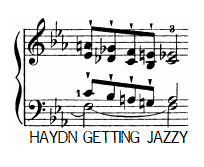
In one of most significant Haydn’s developments, after playing the secondary themes several times in keys as far as B flat minor or E flat minor, fierce modulation forces try to impose their strength over the rest. We will see the harmony go through places Haydn never explored before, so please stay aware of the upcoming image, leading to the end of the development, when the key slowly is turning back to C minor.
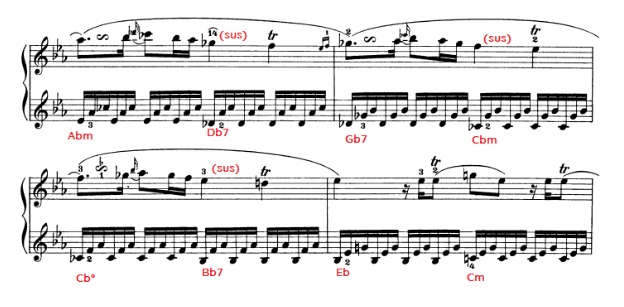
Before the recapitulation, an intense and loud parallel motion passage is displayed.
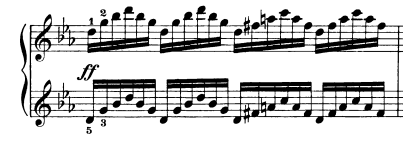
Moreover, after several turns recycling some material from the bridge, we go back to the main theme. The recapitulation happens at bar 69. After repeating just, the first four bars, changes happen immediately after, reaching colossal intensity.
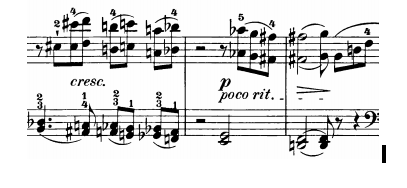
The Transition continues in a remarkably similar fashion to the exposition one, just preparing to reach the secondary theme this time in C minor. About to hit this moment, in the graphic, we can see how Haydn develops a II – V – I in a very fancy manner, stretching the second degree in between hands and then reaching the keynotes on important rhythm moments on the adagio on the right hand. On the next bar, gradually and note by note a dominant it is built but with a flat ninth to add more tension and drama.

The last page is just a repetition of the last bars of the exposition – this time on C minor key. Some material previously used appears under new forms just to compile a couple of bars of exit. The chosen range of the piano to cadence is over lower than average in this style:
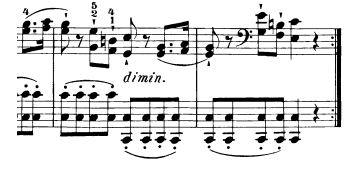
TECHNICAL ASPECTS FOR PIANISTS:
Synchronized forearm movements are required to play every double note or chord. Our fingers should be ready to articulate at a maximum level to reach the dexterity needed to perform this piece. Almost every fast passage is in comfortable positions for the hands.
The broken octaves on the left hand can be played by a composed technique – playing the first one with the forearm and then use a rotation movement to reach the octave reflection; it will work bot starting with the fifth or first finger.
Each double note has to be appropriately phrased not to block any other layer. It is always a good idea to practice layer by layer – practicing the intermediate voices of the chords independently too.
In bar 81, to accomplish this movement in the left hand, a forearm entry is required in the first note. All the other notes should be played with synchronized rotation movements. Each note should be louder, and we should reach to a small peak on the top note.

In order to perform all the grace notes and ornaments properly, it is vital to leave the keyboard immediately when we play a repeated note, so we can enter again as soon as we can on the second one. These passages should always be started with a forearm movement, to reinforce with energy the quick movements and add crisp sound when necessary.
SECOND MOVEMENT
Andante con moto is the tempo indication, so we must face the beginning of this piece getting ready to play slowly, but with some movement, and trying to find an exquisite tone to supplement this character.
The first theme has no chords, and the counterpoint of two gentle voices creates the harmony, the left hand steady and marking the pace as the right will play expressive embellished melodies with all the traditional ornamentations: thrills, suspensions, scales and escape notes. Balanced phrases are shown, and a traditional harmony operates; Haydn only modifies the accidentals to add some leading notes to dominant chords, only twice in these first eight bars.

A very brief transition happens next, and for the first time, we find chords: thirds on the left hand. The right-hand stretch the ratio climbing harder and harder, leaning on thrills to add strength and conviction.
After some bars, the second subject kicks in -in E flat major key- with the left-hand playing accompaniment in thirds in a similar fashion and the right hand now playing a new central theme with a grupetto and octaves.
The hands played a bit delayed, and that makes it sound tangled and beautiful. The harmony gets dense, and more sophisticated embellishments take the lead on the right hand. To close the section with a small 4-bar coda, the composer introduces the head of the main theme on the left hand to generate a convergent reminiscence.
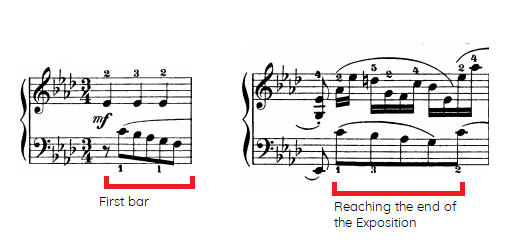
Haydn usually starts the developments with the main theme in the fifth degree, and this 1771 sonata is no exception. Harmonic exploration starts after that with the same texture that appeared before: thirds on the left hand moving by small steps and the right hand singing one semiquaver delayed in the open range.
Diminished and dominant chords lead to this zone of unstable harmony. It remains very tense when the right-hand hints the secondary theme, and later on, Haydn repeats pairs of bars. A 4-bar climbing challenge will take the music into a new level: a marvellous full-of-life climax with a left hand that descends from top to bottom as the right-hand escalate o top, exploding into one of Haydn’s best piano moments ever.
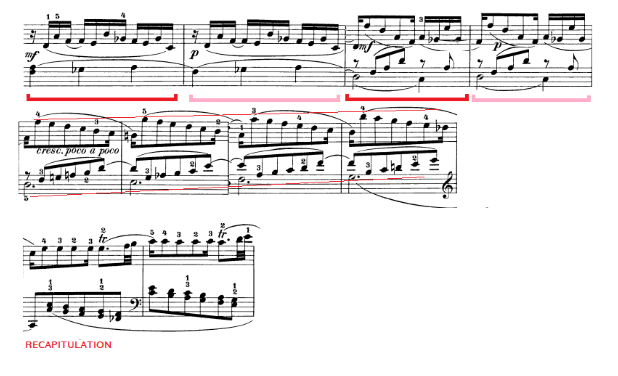
On the score above, we can appreciate the pairs of repeated bars and the built in to reach the recapitulation. Check how the first note of each bar climbs one by one and all the sequenced notes after that.
When the music reaches the secondary theme, this time it happens in the key of A-flat major. It goes on as an exact transposition of the same section in the exposition until the end.
Regarding the technical side, the piece demands to be played with arm movement the legato long sounds and with delicate finger movement -with a slow attack speed- the melodies in both hands. The tone should be neat and pure to maintain the cleanliness of the sound.
THIRD MOVEMENT
Beautifully shaped in Sonata form, as the previous movements, this number is fast, in ¾ meter, and demands a crisp and bright execution. The articulations are significant to accomplish the real character of this piece. The fact that all three movements are in Sonata form gives a sense of uniqueness to this piece, as commonly, only the first movement follows this form only, leaving the rest of the movements usually in ternary forms or rondo forms.
Once again, as in many other previous volumes, we can find scales and thirds as primary generators of music. Links by two and varied articulations are required in the right hand. Like in the first movement, the theme appears replicated one octave lower and with a contrasting dynamic.
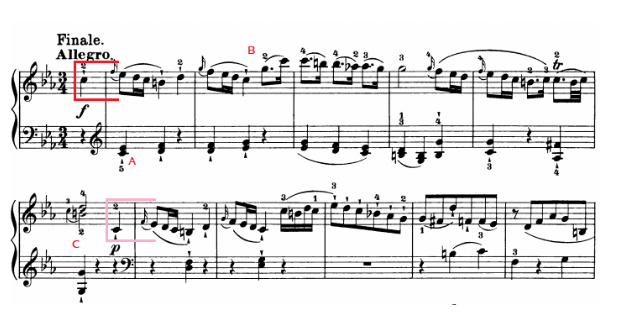
On the score:
A) Thirds building the accompaniment, traditional in the composer’s style
B) Crisp articulation on the right hand: links by two and intercalated detached and slurred notes.
C) Imperfect cadence to the Dominant, featuring a Period as bars 1-4 serves as an antecedent
They are marked in red and pink: the theme and the theme again one octave lower and softer.
With a sequence of descending notes starting on E flat, the Transition starts. This pattern happens later in different voices: on the lower octave first, and most frequently accidentals appear as we start our way to E flat Major: the relative Major.
The second subject happens in bar 21, and we depart from a B flat seventh chord. The right-hand presents a pattern that will lead the hay in bars to come.
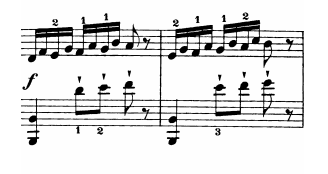
And so it goes, changing later the pattern in this beautiful section demanding cross-hand execution. Both hands create a parallel notes passage between the last semiquaver of each group and the left-hand note.

Haydn expends the next bars settling E flat major as the main key with several turns around the new root. In summary, in between bars 41 and 46, there is a closing subject that works only by thirds, starting on the right hand and shared between hands after that, taking the section to its end with a suspended chord.

In the development, the main subject appears presented in the relative Major, as always. It is almost an exact repetition. When the descending pattern that happens in the first part starting in E flat major now happens in A flat major.
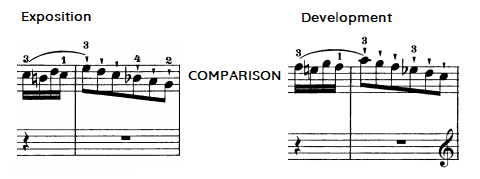
Some material from the second subject is used as a departure point to build a virtuoso and beautiful passage – technically demanding for the right hand, making turns around the chords of D seventh and G minor, finally leading into a G minor resolution.
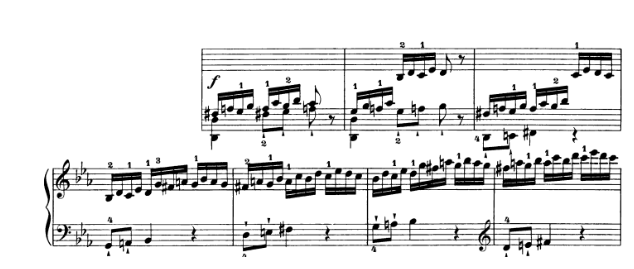
Some other material from the second section is now used to create the texture of almost an entire page, stretching the voices, stockpiling stress and tension, and exploding in an imperfect cadence before leading into the recapitulation. Some analysis of the finals bars of the development can be found here, with very surprising chords due to the internal movements of the voices and the ’embellishment’ note -third semiquaver of each group:
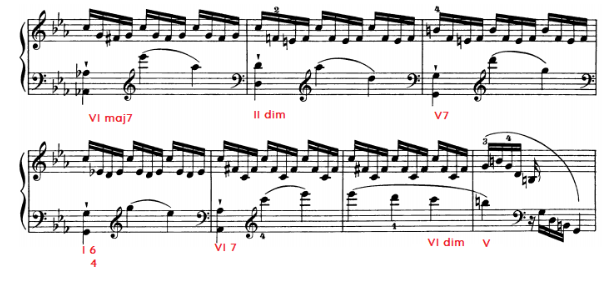
The recapitulation happens most ordinarily – barely a mere repetition with a shorter secondary theme adapted to C minor key. The Transition is now replaced with this beautiful melody – played with hands delayed going down and down and down until reaching the Fifth degree.
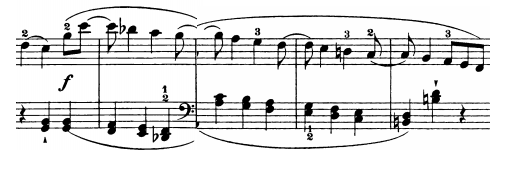
From that point, something of the secondary theme happens, with some modifications in the internal structure of the voicing to make it work now in a minor mode, in contrast with the significant color of the exposition.
The closing subject succeeds in a similar manner related to the one in the exposition – moving gently by thirds, and leading to a dry suspended ending.
TECHNICAL NOTES:
Fortunately, this movement is the shortest; some finger dexterity is needed but not all the way through. The concept to master is how we have to enter and leave the keyboard to produce the crisp articulations. Combinations of forearm and finger movements are required.
Curiosity Corner:
Another work for piano in c minor by Haydn:
Piano Trio in C minor, Hob.XV:13
Learn music analysis with WKMT London.

